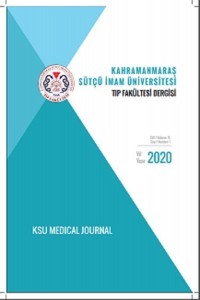Tam Tıkalı Ana İliak Arterin; İonize Kontrast Madde Kullanmaksızın CO2’i Kontrast Ajan Olarak Kullanarak Endovasküler Yöntemle Tedavisi
CO₂, kontrast ajan
Endovascular Treatment of Totally Occluded Main Iliac Artery Using CO2 without Iodinated Contrast Medium
CO₂, contrast medium,
___
- 1. Tendera M, Aboyans V, Bartelink ML, Baumgartner I, Clément D, Collet JP, et al. ESC Guidelines on the diagnosis and treatment of peripheral artery diseases: Document covering atherosclerotic disease of extracranial carotid and vertebral, mesenteric, renal, upper and lower extremity arteries: the Task Force on the Diagnosis and Treatment of Peripheral Artery Diseases of the European Society of Cardiology (ESC). Eur Heart J. 2011; 32: 2851-2906
- 2. Katsiki N, Athyros VG, Karagiannis A, Mikhailidis DP. Contrastinduced Nephropathy: An ‘‘All or None’’ Phenomenon? Angiology. 2014; 66: 508-513.
- 3. Maioli M, Toso A, Leoncini M, Gallopin M, Musilli N, Bellandi F. Persistent renal damage after contrast-induced acute kidney injury: incidence, evolution, risk factors, and prognosis. Circulation. 2012; 125: 3099-3107.
- 4. Moos JM, Ham SW, Han SM, Lew WK, Hua HT, Hood DB et al. Safety of carbon dioxide digital subtraction angiography. Arch Surg. 2011; 146: 1428-1432.
- 5. Beese RC, Bees NR, Belli AM. Renal angiography using carbon dioxide. Br J Radiol. 2000 Jan. 73(865):3-6.
- 6. Moresco KP, Patel N, Johnson MS, Trobridge D, Bergan KA, Lalka SG. Accurac of CO2 angiography in vessel diameter assessment: a comparative study of CO2 versus iodinated contrast material in an aortoiliac flow model. J Vasc Interv Radiol. 2000; 11: 437-444.
- 7. Diaz LP, Pabon IP, Garcia JA, de la Cal Lopez MA. Assessment of CO2 arteriography in arterial occlusive disease of the lower extremities. J Vasc Interv Radiol. 2000; 11: 163-169.
- ISSN: 1303-6610
- Yayın Aralığı: Yılda 3 Sayı
- Başlangıç: 2004
- Yayıncı: Kahramanmaraş Sütçü İmam Üniversitesi
Deney hayvanlarındaki iskemi-reperfüzyon hasarı modellerinde yeşil çayın etkileri
Isparta'da Üç Farklı Okulda Enterobius vermicularis'in Dağılımı
Mehmet Acıöz, Hazal ZORBOZAN, Tuba ÖZTÜRK
Görme Bozukluğu ve Baş Ağrısı ile Başvuran Hastada Dev Araknoid Kist Olgusu
SERKAN KIRIK, Olcay GÜNGÖR, Sedat IŞIKAY, Yasemin ÇOBAN, Yasemin KIRIK
Mahmut Tuna KATIRCIBAŞI, Uğur ÖZKAN
Hemşirelik Bölümü Öğrencilerinin Yaşam Bulgularina İlişkin Bilgi Düzeyleri
Ayşe Asli OKTAY, Fadime YEL, Merve GÜLPAK, Hacer UZUN, Özlem ÖNAL
Hemodiyaliz Hastasında Kateter İlişkili İntraatrial Enfekte Trombus
Mehmet Kirişçi, Fatma Betül Güzel, Songül Işıktaş, Hakan Güneş, Aydemir Koçarslan, Selçuk Nazik, Ertuğrul Erken, Orçun Altunören, Özkan Güngör
Uğurkan ERKAYIRAN, Belgin SAVURAN ÜÇOK, Ali SEVEN, Şule ÖZEL, Ali Sertaç BATIOĞLU
